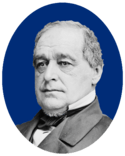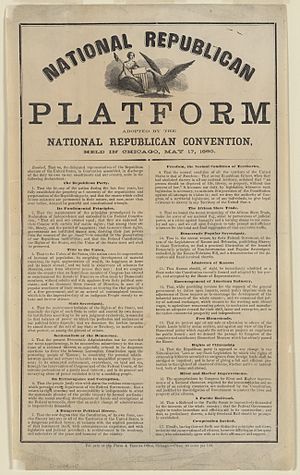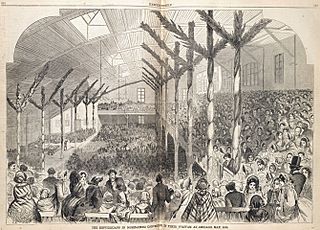1860 Republican National Convention facts for kids
| 1860 presidential election |
|
 
Nominees
Lincoln and Hamlin |
|
| Convention | |
|---|---|
| Date(s) | May 16–18, 1860 |
| City | Chicago, Illinois |
| Venue | The Wigwam |
| Candidates | |
| Presidential nominee | Abraham Lincoln of Illinois |
| Vice presidential nominee | Hannibal Hamlin of Maine |
| Other candidates | William H. Seward |
The 1860 Republican National Convention was a big meeting where the Republican Party chose its candidates for president and vice president. This important event happened from May 16 to 18, 1860, in Chicago, Illinois. At this convention, the party picked Abraham Lincoln from Illinois to run for president. They also chose Senator Hannibal Hamlin from Maine to be his running mate for vice president.
Before the convention, Senator William H. Seward from New York was seen as the most likely person to win. But Lincoln, along with other strong candidates like Governor Salmon P. Chase and former representative Edward Bates, also had a lot of support. On the first vote, Seward was ahead, but he didn't have enough votes to win right away. Lincoln was a strong second.
During the second vote, many delegates who had supported Senator Simon Cameron switched their votes to Lincoln. This made Lincoln almost tied with Seward. Finally, on the third vote, Lincoln gained even more support from delegates who had backed other candidates. This helped him secure the nomination.
For vice president, Hannibal Hamlin won on the second vote. He beat out Cassius Clay and other candidates.
The team of Lincoln and Hamlin went on to win the 1860 election. After becoming president in 1861, Lincoln gave important jobs in his cabinet to the main opponents he had faced at the convention. Seward became the secretary of state, Chase became the secretary of the treasury, Bates became the attorney general, and Cameron became the secretary of war.
Contents
History of the Convention
Why the Convention Happened
By 1860, the old Whig Party in America had mostly disappeared. Many politicians from that party, along with former Free Soilers (who opposed slavery spreading), joined the new Republican Party. This new party was against slavery.
Even though the Republican candidate in 1856, John C. Frémont, didn't win, the party grew stronger in the Northern United States. This happened as the big disagreement over slavery became more intense.
Party leaders decided to hold their 1860 meeting in Chicago. Chicago was a growing city with about 110,000 people. The city didn't have a hall big enough for the convention. So, they built a special temporary wooden building called the "Wigwam". It was designed to hold ten thousand people, including delegates, guests, and observers. The building worked very well. It had great views and good sound, so everyone could hear the speakers clearly.
Many curious people came to the "Wigwam" to watch the convention. Delegates from each state sat together. There were no delegates from the Southern states where slavery was common, such as North Carolina, South Carolina, and Georgia.
The number of votes each state had was generally based on how many representatives they had in Congress. States in the Northeast, like New York and Pennsylvania, had the most votes. States in the Midwest, like Ohio and Illinois, also had many votes. In total, there were 466 delegate votes.
What Happened Each Day
The convention officially started on May 16. David Wilmot, a former U.S. Representative, was chosen to lead the meeting temporarily. He was famous for proposing a law in 1848 that would have stopped slavery in new states. When he was chosen, Wilmot gave an important speech. He said that a powerful group had been trying to spread slavery across the country. He declared that the Republican Party's goal was to stop this.
The first day was spent on organizing the convention. They chose committees, like one to check the delegates' credentials and another to write the party's goals. There were no big arguments about who could be a delegate, though a group claiming to represent Texas was not allowed to vote. A committee was also formed to write the party's platform. This committee worked quickly and finished its report by the evening of the second day, May 17.
The Party's Goals
The party's goals, called the "platform," were read aloud. Everyone cheered loudly, and there was a quick move to approve the document without any changes. However, someone tried to add a famous line from the Declaration of Independence. This line said, "All men are created equal; and they are endowed by their Creator with certain inalienable rights..."
At first, the convention rejected this addition. This made Joshua Reed Giddings, a long-time Congressman from Ohio who proposed it, walk out. But the convention quickly thought about it again. They added the line, and Mr. Giddings returned to his seat, solving the problem.
The 1860 Republican platform had 17 main ideas. Ten of these ideas were directly about stopping slavery from spreading. They also talked about the Fugitive Slave Act and keeping the country united. The other seven ideas were about different topics.
For example, the platform called for a protective tariff (a tax on imported goods to help local businesses). It also supported the Homestead Act, which gave free land to settlers. It wanted to keep current naturalization laws (how immigrants become citizens) and ensure full rights for all citizens. The platform also supported improving roads and canals, and building a railroad across the country.
Besides keeping the country united, all these promises were later put into action. This happened during Abraham Lincoln's time as president or by the presidents who came after him.
How Votes Were Counted
The Republican National Convention met in mid-May 1860. This was after the Democrats had trouble at their own meeting in Charleston, South Carolina. With the Democrats in disarray, Republicans felt confident. They thought they could win many Northern states. William H. Seward from New York was seen as the top choice. Others like Salmon P. Chase from Ohio and Edward Bates from Missouri were also strong candidates. Abraham Lincoln from Illinois was less known and not expected to win against Seward. Seward had been a governor and senator and was a very skilled politician.
However, as the convention went on, it became clear that Seward, Chase, and Bates had upset different groups within the Republican Party. Seward was seen as too extreme by some. His speeches about slavery predicted conflict, which worried moderate delegates. He also opposed nativism, which hurt his support. Even his old friend, Horace Greeley, a powerful newspaper publisher, no longer supported him.
Chase, who used to be a Democrat, had upset many former Whigs. He also opposed tariffs that Pennsylvania wanted. Even his own state's delegates had some issues with him. But Chase's strong anti-slavery views made him popular with radical Republicans.
Bates was a more conservative candidate. He got support from Horace Greeley, who just wanted to stop Seward. Bates's views on slavery and equal rights upset some of his supporters. Also, German Americans in the party didn't like Bates because of his past ties to the Know Nothing party.
Then came Lincoln. Lincoln was not unknown. He had become famous during the Lincoln–Douglas debates. He had also served as a representative in the House. He had been thinking about running for president since 1858. He made sure his debates were widely published. He also had a biography written about himself. He gained a lot of attention with his Cooper Union speech in February 1860. This speech might have helped him get the nomination.
Lincoln had not yet officially announced he was running. But his Cooper Union speech was excellent. He gave it in Seward's home state, and Greeley was there. In the speech, Lincoln showed that the Republican Party was made of moderate people, not crazy extremists, as the South and Democrats claimed. After that, many people wanted Lincoln to speak. As the convention got closer, Lincoln didn't campaign very hard. He believed the "office should seek the man."
This happened at the Illinois state convention, a week before the national one. A young politician named Richard J. Oglesby secretly found some fence rails that Lincoln might have split as a young man. He brought them into the convention with a banner calling Lincoln "The Rail Candidate" for President. Lincoln received a huge cheer, surprising even his supporters.
Even with strong support from his home state, Lincoln faced a tough challenge. He worked to become the second choice for most delegates. He knew the first vote at the convention probably wouldn't have a clear winner. He helped make sure the convention was held in Chicago. This city would naturally be friendly to Lincoln, who was from Illinois. He also made sure that all the Illinois delegates would vote for him together. Lincoln himself did not go to the convention. He left the job of getting votes to his friends Leonard Swett, Ward Hill Lamon, and David Davis.
On the night of May 17–18, Lincoln's friends worked hard to get anti-Seward delegates to vote for Lincoln. They showed that Lincoln already had the second most support after Seward, which convinced some. They also made a deal with Simon Cameron from Pennsylvania. Cameron knew he couldn't win the nomination himself. He controlled Pennsylvania's delegates. He offered his support if Lincoln would promise him a cabinet job and control over government jobs in Pennsylvania. Lincoln didn't want to make such a deal. From Springfield, he sent a message saying, "I authorize no bargains and will be bound by none." Despite this, Davis reached an understanding with Cameron. This eventually led to Cameron becoming the Secretary of War.
The next day, May 18, voting for the nomination began. Seward led on the first vote, with Lincoln far behind. But on the second vote, the Pennsylvania delegates switched to Lincoln. Other delegates also changed their votes. This put Lincoln almost tied with Seward. Lincoln's moderate views on slavery, his long support for economic issues, his Western background, and his strong speeches were exactly what the delegates wanted. On the third vote on May 18, Lincoln won the nomination by a large margin. Senator Hannibal Hamlin from Maine was chosen for vice president. He beat Cassius M. Clay. Hamlin was surprised by his nomination. He said he was "astonished" and "neither expected nor desired it."
Presidential Candidates
-
Former Representative
Abraham Lincoln
from Illinois -
Cassius M. Clay
from Kentucky -
U.S. Representative
Jacob Collamer
from Vermont -
U.S. Senator
William L. Dayton
from New Jersey
Presidential Voting Results
| Presidential Ballot | |||||
| Nominee | 1st | 2nd | 3rd | 3rd | |
|---|---|---|---|---|---|
| William H. Seward | 173.5 | 184.5 | 180 | 111.5 | |
| Abraham Lincoln | 102 | 181 | 231.5 | 349 | |
| Simon Cameron | 50.5 | 2 | 0 | 0 | |
| Salmon P. Chase | 49 | 42.5 | 24.5 | 2 | |
| Edward Bates | 48 | 35 | 22 | 0 | |
| William L. Dayton | 14 | 10 | 1 | 1 | |
| John McLean | 12 | 8 | 5 | 0.5 | |
| Jacob Collamer | 10 | 0 | 0 | 0 | |
| Benjamin F. Wade | 3 | 0 | 0 | 0 | |
| John M. Read | 1 | 0 | 0 | 0 | |
| Charles Sumner | 1 | 0 | 0 | 0 | |
| John C. Fremont | 1 | 0 | 0 | 0 | |
| Cassius M. Clay | 0 | 2 | 1 | 1 | |
After the third vote, Lincoln was very close to getting the 234 votes he needed. Robert K. Enos, a delegate from Ohio, helped by getting three other Ohio delegates to switch their four votes to Lincoln. This gave Lincoln enough votes to win the nomination. This change caused many more delegates to switch to Lincoln on the fourth vote. In the end, Lincoln received 349 out of 466 votes.
Vice Presidential Candidates
Senator Hannibal Hamlin from Maine was chosen as the vice presidential candidate. He won against Cassius M. Clay from Kentucky.
Candidates for Vice President
-
Anti-slavery planter Cassius M. Clay of Kentucky
-
Representative John Hickman of Pennsylvania
-
Former governor Andrew H. Reeder of Kansas
-
William L. Dayton
Former U.S. Senator and 1856 vice presidential nominee, from New Jersey
Vice Presidential Voting Results
| Vice presidential ballot | |||
| Nominee | Home State | 1st | 2nd |
|---|---|---|---|
| Hannibal Hamlin | Maine | 194 | 367 |
| Cassius M. Clay | Kentucky | 100.5 | 86 |
| John Hickman | Pennsylvania | 57 | 13 |
| Andrew H. Reeder | Pennsylvania & Kansas | 51 | 0 |
| Nathaniel Banks | Massachusetts | 38.5 | 0 |
| Henry W. Davis | Maryland | 8 | 0 |
| Sam Houston | Texas | 6 | 0 |
| William L. Dayton | New Jersey | 3 | 0 |
| John M. Read | Pennsylvania | 1 | 0 |

























